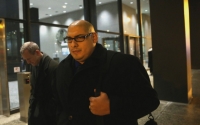How a bionic suit designed for soldiers helps paralyzed people walk again
The first wheeled furniture for the disabled dates back to 6th century China. The first dedicated wheelchair made its debut in 1595. Now, modern science is finally coming up with ways to help people with paralysis stand tall again.
"TechKnow" contributor Phil Torres travels to Aspen, Colo., to meet Amanda Boxtel, the first person in the U.S. to purchase and receive an Ekso Bionics exoskeleton suit -- called E-Legs -- of her very own. More than 20 years ago, Boxtel was paralyzed during a skiing accident.
Young kids at a camp in the town where Boxtel lives spent a year helping to raise enough funds to purchase the exoskeleton, which carries a price tag of more than $100,000. "TechKnow" cameras arrived in time to witness the un-boxing of Boxtel's own bionic suit.

The Ekso Bionics' suit, a battery-powered robot, weighs only 50 pounds and can support Boxtel's body, giving her legs the power to stand tall and walk again.

"The moment she stood up, I was just amazed, because she's been sitting down for 21 years," says one of the young campers. "I would've been thrilled to be in that position."
"That was my dream right there," says a young girl. "All I wanted to see was her walk."
Boxtel got the call asking if she was interested in a role as one of Ekso Bionics' test pilots, or Ekso Ambassadors, in 2010. The suit has completely changed Boxtel's expectations for herself and her future since then. After her accident, she was told that she'd never walk again. The bionic suit has allowed her to prove that verdict wrong.
"Probably the most profound moment was when I stood up, and I tried to see the children's faces. Some of them -- the really little ones -- they were just in awe," Boxtel says of demonstrating the suit for campers for the first time. "And then to have that heart-to-heart hug [with adults]. When I hug in a wheelchair, there's a disconnect."

She even got to hug the ski patroller who first found her after her accident and saved her life.
"He looked at me in my eyes -- standing up eye-to-eye, and he said, 'I never knew that you were this tall,'" Boxtel says.
Ekso Bionics' headquarters are located in Richmond, CA. Until recent months, Boxtel has had to travel back and forth to their facilities to use the bionic suit. Though people in her life in Colorado knew that a robotic device was helping her walk, the un-boxing of her own personal suit is the first time they're able to see it happen live.
"The first time I stood up, I went home and I cried hard, in all honesty. These were emotions that I had been dreaming about for so long, and I felt so good in my body. I slept hard, and I wasn't in pain."
The technology for the exoskeleton has evolved to become a cutting-edge and revolutionary rehabilitation tool for injured or permanently paralyzed individuals. But it was first conceived for the military, intended to support soldiers' bodies in combat. The device was meant to offer troops help in carrying heavy tools packs across long distances, increasing their endurance.

"There's a huge problem in the US military right now, with soldiers getting injuries due to the large loads they're carrying," says Nathan Harding, one of Ekso Bionics' co-founders and inventors.
Finding a new way to shoulder that weight provided the main motivation for Harding and his associates to research and develop new technology in 2005. The biggest breakthrough came from eventually designing a wearable robotic suit that could support its own weight using minimal energy. The Ekso Bionics' suit small battery pack is essential to the suit working properly and one of its biggest successes.
Their Human Universal Load Carrier (HULC) was licensed to Lockheed Martin for further military development in 2009. In 2010, Ekso Bionics' received approvals to allow the company to use their exoskeleton robot for rehabilitative purposes as well.
"It takes over the function of the muscles in your legs," Harding says. "And it can either do it completely... or partially, like for someone who's trying to relearn how to walk."
Researchers are now studying how the bionic suit may improve overall health in people living with paralysis. According to Harding, people who sustain spinal cord injuries each cost the healthcare system $4.6 million throughout their lives. Why? Complications due to spending life in a wheelchair: neuropathic nerve pain, sores, blood clots, and much more.
Boxtel says that, on a scale of 1 through 10, sometimes her pain reaches an 11. She says, "And I live with that. I live with that every day, but when I walk, it dissipates."
Boxtel isn't Ekso Bionics' only prominent test pilot. Jason Gieser is a former police officer injured during a motorcycle accident in 2008. The crash left him paralyzed from the chest down.
"The more free time I walk and the more I'm up, I experience better digestion, better bladder function," he says.
Improvement in basic living are just the smallest joys walking again has given to Gieser. In spring 2013, the Ekso bionic suit also allowed Gieser to walk down the aisle for his wedding.

"It was the most amazing day. I can't even put it into word to describe how important it was for that day to happen just like that," Gieser says.
Reaching that point is the result of extensive work with Ekso's headquarters and physical therapists. During the earliest tests, a physical therapist controls the majority of the suit's function via remote control while walking alongside their patients. This helps the suit's users gradually get used to both the suit and the experience of standing and moving again.
Harding says that test pilots like Boxtel and Gieser have been instrumental in advancing the technology. "They've helped immensely. Everything is unpredictable once you introduce a human into the system. I remember being in the room with 13 PhDs, and they all had a different idea of what would be the exact way to control something. Without people like Amanda and Jason, we're really be at a standstill."
Right now, Ekso Bionics' suit is still considered a rehabilitative machine only and not meant for daily, fully independent activity. Ekso Bionics hopes that the Food and Drug Administration (FDA) will eventually approve the suit for regular home use. In the meantime, trained physical therapists must help patients operation the suit in rehab environments only. If approved for a wider range of use, Ekso believes they'd see an increase in demand for the suit and a decrease in price.
"There's nothing about this device that should make it any more expensive than, say, a high-end motorcycle," Harding says. "We just have to get to those kind of quantities in production."
Collectively, the Ekso Bionics exoskeleton has helped test pilots and patients across the country take more than 3 million steps since the company's inception in 2005. The suits are being used in 40 hospitals and rehab centers throughout the U.S., and the aim is help even more people get on their feet and walk -- and have those "heart to heart" hugs.
















Error
Sorry, your comment was not saved due to a technical problem. Please try again later or using a different browser.